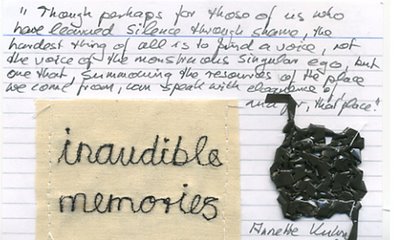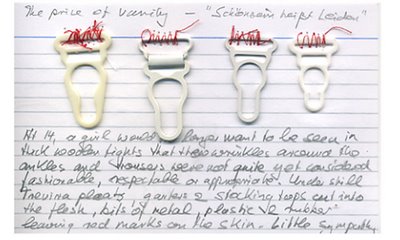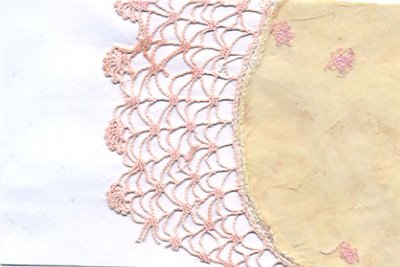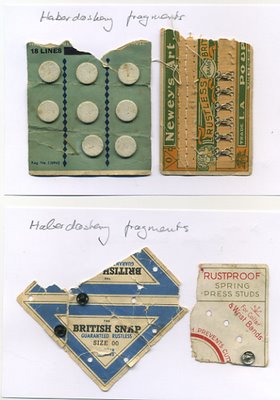Sunday, December 31, 2006
Saturday, December 30, 2006
Friday, December 29, 2006
Thursday, December 28, 2006

Yellow Flower
Stitched by Carmen, my good friend and ex-sister-in-law in Malaga.
"La hize en las tardes de tedio (ahora entranables) en las que cuidaba de mi madre y mi hija. Eran tardes de sabado en las que hubiera preferido estar de marcha, pero que ahora agradesco a la vida haberme dado."
[I made it during those tedious evenings when I was looking after my mother and my daughter. They were Saturday evenings and I would have preferred to go out, but now I am grateful that life gave them to me.]
Wednesday, December 27, 2006
Tuesday, December 26, 2006
Monday, December 25, 2006
Sunday, December 24, 2006
Saturday, December 23, 2006

Gift Ribbon (Germany 1950s)
Ribbon was precious, kept, ironed and re-used, as was wrapping paper. In my parent's bedroom, there was a drawer full of paper and ribbons. For every birthday and Christmas, the same ribbons and papers would reappear, to be carefully folded and put away afterwards.
I have kept a few of these ribbons - they are fragile & delicate and a reminder of festive occasions.

Carolyn Steedman on housework:
"I take a furtive and secret pride in the fact that I can do all these things, that I am physically strong, can lift and carry things that defeat other women, wonder with some scorn what it must be like to have to learn to clean a house as an adult, not having the ability laid down as part of the growing self. Like going to sleep by contrasting a bed with a pavement, I sometimes find myself thinking that if the worse comes to the worst, I can always earn a living by my hands; I can scrub, clean, cook and sew; all you have in the end is your labour."
Carolyn Kay Steedman, Landscape for a Good Woman: A Story of Two Lives, Rutgers University Press, New Brunswick, New Jersey 1987, p.43
Friday, December 22, 2006

Dishcloth,100% cotton, handknitted by a member of Eastbourne Blind Society, 2006
When I was at school, we had to crochet a dishcloth - it took a long time to make and the edges just would not stay straight. After so much struggle, it seemed far too precious to use. Eventually, two decades later, I finally did use it - what else can you do with a dishcloth? It didn't last very long and was thrown out. That was before my interest in everyday textiles developed, or was it? The memory has stayed with me - it was pale yellow cotton with a pale pink stripe at both ends. I remember my mother complaining that the yarn recommended by the teacher was very expensive.
My mother used to cut up old underwear that was beyond mending for cleaning cloths. This was a source of great embarrassment to me - wiping the table with my father's old underpants was taking recycling a step too far.
Thursday, December 21, 2006

"... her work suggested a kind of infinitive incompletion - that a woman's work is never done; how the work of all the Marthas, and all the Marys too, all the work, both temporal and spiritual, in this world, and in preparation for the next, will never be over - always some conflicting demand will occur to postpone indefinitely any and every task. So ... there was no need to hurry!
Which was just as well, because she was ... almost ... worn out."
Angela Carter, Nights at the Circus, Picador, London 1984, pp 95, 96
Wednesday, December 20, 2006
Tuesday, December 19, 2006


"Charity shops always have a little pile of much washed fine linen and embroidery. They make me think of the hours of labour women have spent on these pieces of needlework. I feel a sense of loss, that women's labour, and the aesthetics that have grown out of that labour, are given so little value.
There is another feeling these little pieces of embroidery stir. We did not have fine linen in my family. There was a lack of patience, a willingness to mend and make do. My great-grandmother had worked in the Paisley Cotton mills in the 1880s. I like to imagine we were a highland family who suffered in the Highland Clearances. But the truth is that the link, if there was one, and my relationship to material is to industrial processes and not the handmade. Industrial experience had a profound effect on our values, and this must have played a part in the reasons why I never became the artist I was trained to be. I did not come from a family in which women had maintained the tradition of hand-making."
Lynda Morris, Minimal Womanhood, in Nikos Papastergiadis (ed), Annotations I: Mixed belongings and unspecified destinations, Institute of International Visual Arts, 1996, p. 64
Monday, December 18, 2006
Keeping stuff for future use

Towelling fabric
Retrieved from rag bag, print studio Eastbourne College of Art and Technology, 1996
I liked the fabric and thought it was too nice to be used as a rag. I was going to make something out of it, maybe washbags for the children, but I never did. For the last 10 years, it has been in one of my fabric boxes, rescued but not yet recycled.
Postscript: Another almost 4 years later, in the spring of 2010, some bits of the towelling fabric have found their way into my work, are indeed, clothing Sweet Delights, part of my textile cabinet of wonders and my forthcoming PhD thesis and exhibition.
Sunday, December 17, 2006
Mended fairytales


Fabric also used for:
"Latchkey Kids" in
"The Quest for the Inner Child: Souvenir Shop"
OVADA Gallery Oxford
Quest: The Artist as Pilgrim
18 Jan - 18 Mar 2006
Review
Inaudible memories

"Though perhaps for those of us who have learned silence through shame, the hardest thing of all is to find a voice, not the voice of the monstruous singular ego, but one that, summoning the resources of the place we come from, can speak with eloquence of, and for, that place."
Annette Kuhn, Family Secrets: Acts of Memory and Imagination, Verso, London/New York 1995, p.103
Two memories
Seeing TV images & hearing the sound of tangled masses of video/audiotape caught on wire fences when the Taliban prohibited music in Afghanistan
Seeing hats crocheted out of audiotape as part of a window display at Tiffany in Bond Street. I was fascinated and made a 'tape' hat for my friend R. Did she ever wear it? Does the tape still carry the sound even if we can't hear it?
The Sound of Silence: Inaudible Memories
The Haberdashery Shop


"I remember the layout of the shop, how I loved to touch the fabrics, my grandfather sitting me on the measuring table to play, or letting me sit under the table with big boxes of buttons and sequins and feathers to play with. I remember feeling happy and special." BBC Radio 4 "The Memory Experience"
Saturday, December 16, 2006
The price of Vanity - "Schoensein heisst Leiden"

At 14, a girl would want no longer to be seen in thick woolen tights that throw wrinkles around the ankles, and trousers were not quite yet considered fashionable, respectable or appropriate. Under stiff Trevira pleats, garters and stocking tops cut into the flesh, bits of metal, plastic and rubber leaving red marks on the skin. Little sympathy from our mothers: grateful we should be to be able to have nylons without having to compromise our respectability, stories about the American and English soldiers, "overfed, oversexed and over here", stockings, cigarettes, chocolates in exchange for what, we wondered and never knew.
Laddered stockings were taken to the haberdashery shop for invisible mending. My mother used to count the ladders - to decide whether it was worth having them mended.
We just used nail varnish, soap, glue or hairspray to deal with ladders.


Hairnets
When in the sixties, we were happily and unknowingly blowing holes into the ozone layer with generous amount of hairspray, my grandmother still wore hairnets , invisible, spidery like cobwebs, holding curls and waves in place. As her eyesight got worse with age, she stopped using them because she could no longer see them and they got lost.
invisible memories

Net curtains: looking out without being seen, preventing others to look in. Lacy interface between the public and the private. Presenting a clean front .
The net curtains were washed frequently with a special detergent that promised to prevent the yellow tinge that net curtains used to acquire over time. Then put up while still damp and rigorously pleated into shape. All pleats had to be exactly the same distance and depth, the net was measured & the folds held rigidly in place with pins. Opening the window was difficult: pins could prick or fall out, the pattern of perfection disturbed. For me, these net curtains were the domestic equivalent of a barbed wire fence. Once, as a teenager locked in by my mother, I decided to escape through the bedroom window and ended up with bleeding scratches on my arms and legs from those hundreds of pins (and the spiky houseplant on the windowsill).
See also:
Pauline Gaervey, Domestic boundaries: Privacy, visibility and the Norwegian Window, in Journal of Material Culture, Vol.10, No.2, July 2005, pp 157 - 176














